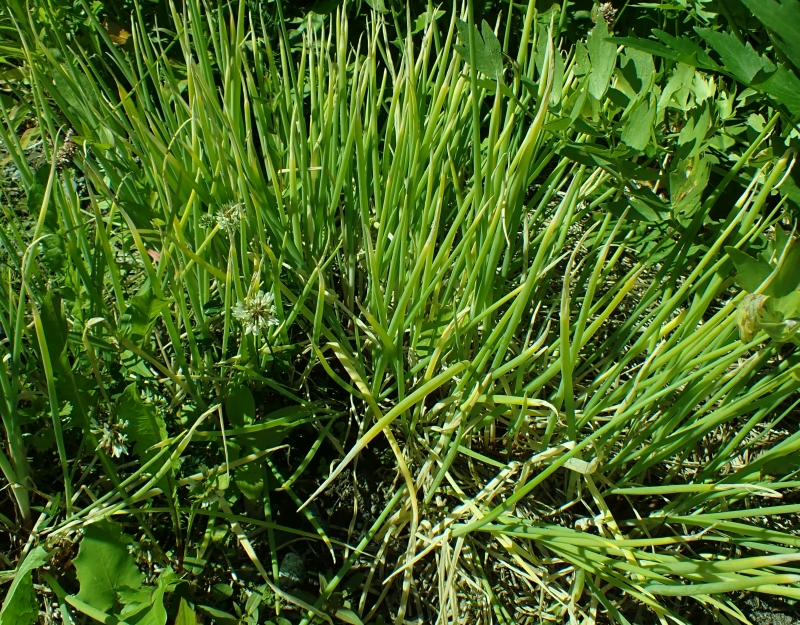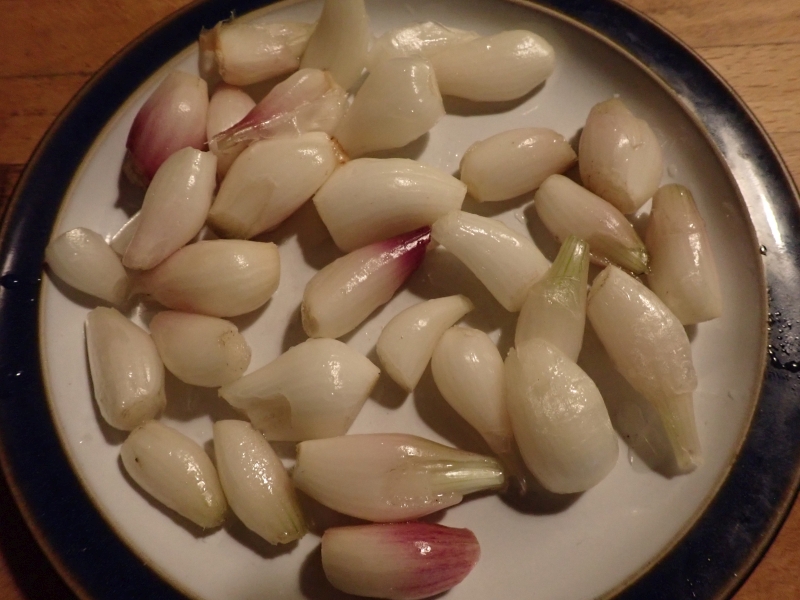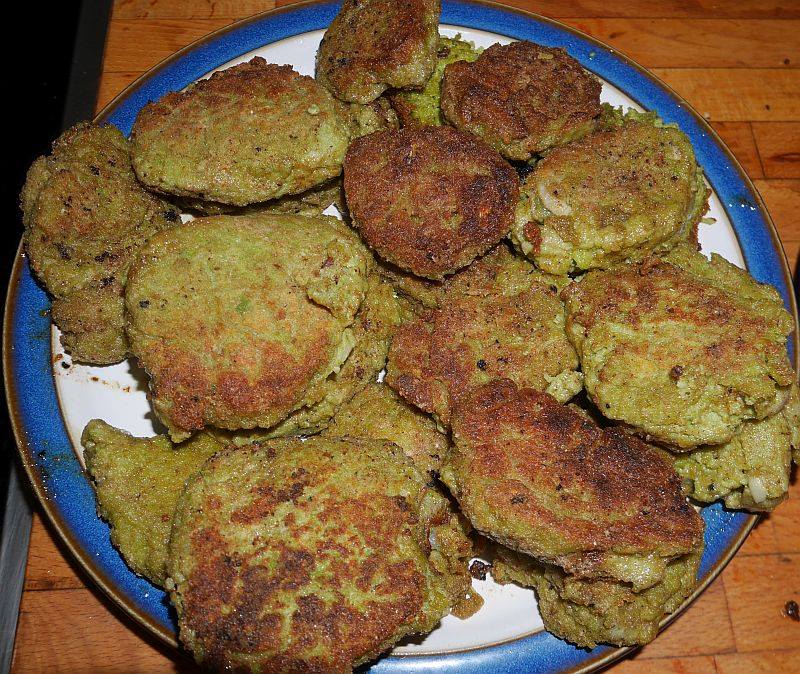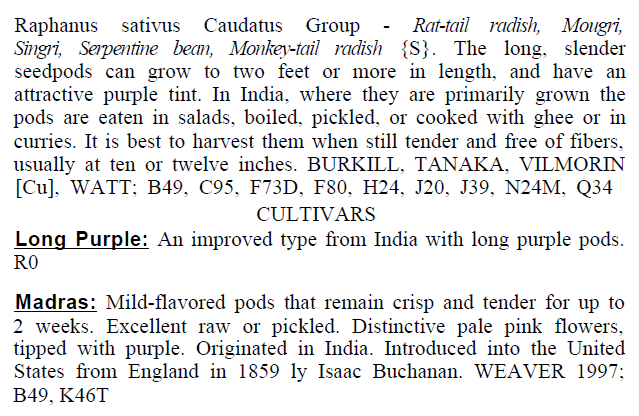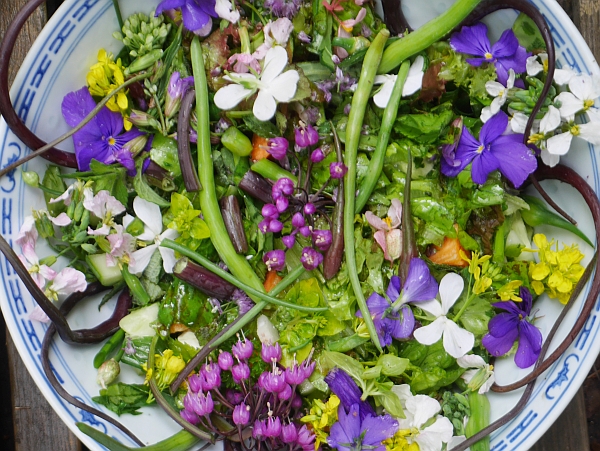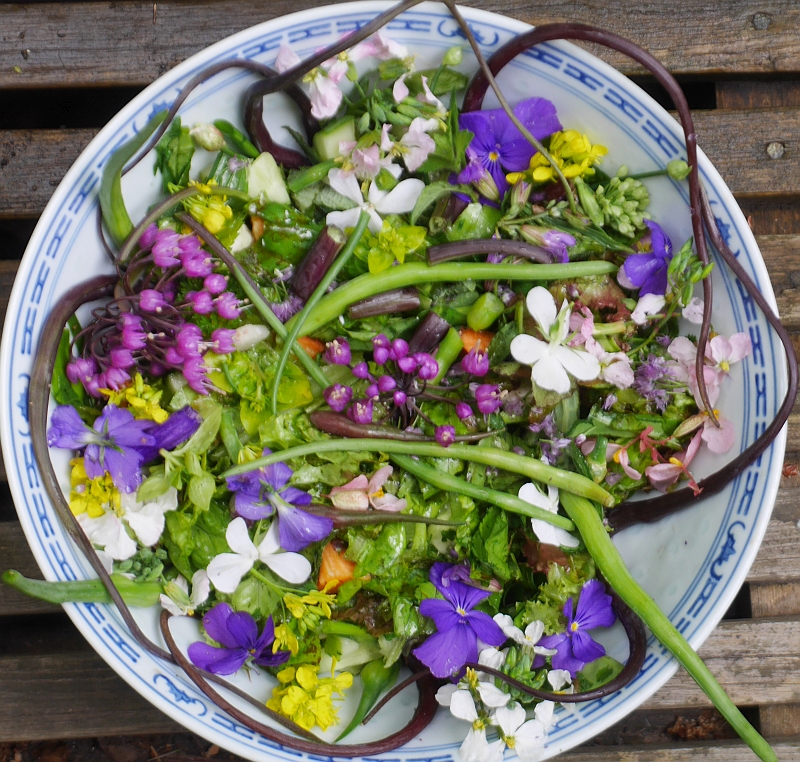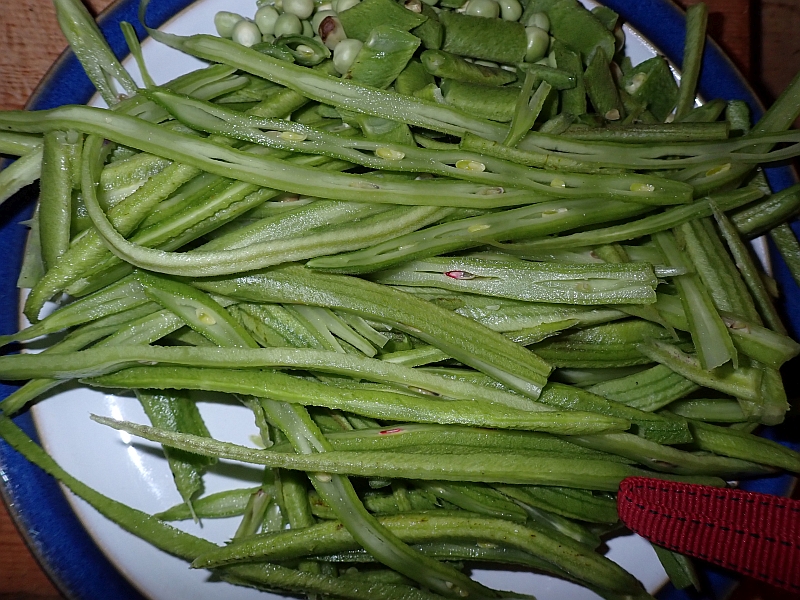
I’ve shared my list of plants that I’ve planted in Trondheim’s World Garden to a few people who’ve asked and now it’s available to anyone who is curious (follow the link).
The World Garden (Verdenshagen) is a garden I’ve created, starting in 2017, to show off the diversity of perennial vegetables, essentially my book Around the World in 80 Plants as a formal garden. Many are edimentals, edientomentals and ediavimentals (i.e, edimentals that are also useful to insects and birds respectively) and demonstrates how growing food can both look good and promote a large biodiversity. The plants are placed geographically around a 12m diameter circle with the centre representing the North Pole, where edibles from arctic and mountain regions of the world are planted.
A few are annuals or biennials, planted in the gaps as the perennials grow and expand. For those of you who like lists, a list of the 359 plants I’ve planted so far is included below the new drone pictures taken in 2024! (thanks to board member Dan Smith). NB! A few of the plants have died, so this isn’t a list of current plants in the garden! I’ve noted this in the list. In addition, a few are planted each spring and overwintered indoors, such as some of the South American tuber crops.
PLANTED IN THE WORLD GARDEN (as of January 2025)
Acanthopanax sessiliflorum (syn Eleutherococcus sessiliflorus); Korean Ginseng
Aegopodium podograria Variegata; Ground elder; Skvallerkål
Agastache foeniculum ; Anise Hyssop; Anisisop
Agastache foeniculum Aureum; Golden Anise Hyssop; Anisisop
Agastache spp.; ;
Alcea ficifolia; ;
Alcea rosea ; Hollyhock; Stokkrose
Allium altissimum “Goliath”; Persian shallot ; Persisk sjalott
Allium ampeloprasum “Elephant Garlic”; Elephant Garlic; Elefanthvitløk
Allium ampeloprasum “Oerprei”; ;
Allium ampeloprasum “Perennial Leek”; Perennial leek;
Allium ampeloprasum “Perennial”?; Perennial leek;
Allium ampeloprasum “Porrum”; Leek; Purre
Allium ampeloprasum var babingtonii; Babington’s Leek;
Allium angulosum x nutans “Norrlandsløk”; Norrland onion; Norrlandsløk
Allium carolinianum ; ;
Allium cernuum “Alan Kapuler”; Nodding onion; Prærieløk
Allium cernuum “Dwarf White”; Nodding onion; Prærieløk
Allium cernuum Miks; Nodding onion; Prærieløk
Allium cernuum Tall; Nodding onion ; Prærieløk
Allium douglasii; Douglas’ Onion;
Allium fistulosum “Ishikura”; Welsh onion; Pipeløk
Allium fistulosum “Nedre Gjetsiden”; Welsh onion; Takløk fra Gudbrandsdalen
Allium flavum “Blue Leaf” ; ;
Allium flavum tauricum; Small Yellow Onion; Doggløk
Allium hookeri var muliense; ;
Allium humile; ;
Allium karataviense; ;
Allium lusitanicum; ; Kantløk
Allium macranthum “Album”; ;
Allium moly; Golden Garlic; Lili Leek; Gull-løk
Allium nutans “Esmee” ; Blue Chives; Sibirsk nikkeløk
Allium nutans “Seedlings” ; Blue Chives; Sibirsk nikkeløk
Allium obliquum; Twistedleaf Garlic; Tvistebladløk
Allium ochotense (Allium ulleungense?); ;
Allium ochotense (syn Allium victorialis); Victory onion; Seiersløk
Allium pskemense; ;
Allium pskemense x fistulosum; Wietse’s onion; Wietsesløk
Allium sativum “Aleksandra”; Garlic; Hvitløk
Allium sativum “Arkus”; Garlic; Hvitløk
Allium sativum “Belarus”; Garlic; Hvitløk
Allium sativum “Cledor”; Garlic; Hvitløk
Allium sativum “Dukat”; Garlic; Hvitløk
Allium sativum “Estisk Rød”; Garlic; Hvitløk
Allium sativum “German Hardneck”; Garlic; Hvitløk
Allium sativum “Ljubasha”; Garlic; Hvitløk
Allium sativum “Lochiel”; Garlic; Hvitløk
Allium sativum “Morado”; Garlic; Hvitløk
Allium sativum “Ornac”; Garlic; Hvitløk
Allium sativum “Romania”; Garlic; Hvitløk
Allium sativum “Tia Pink”; Garlic; Hvitløk
Allium sativum “USSR Rocambole”; Garlic; Hvitløk
Allium sativum “Valdres”; Garlic; Hvitløk
Allium sativum “Vallelado”; Garlic; Hvitløk
Allium sativum “Ävrö”; Garlic; Hvitløk
Allium schoenoprasum Alba; Chives; Gressløk
Allium schoenoprasum Dwarf; Chives; Gressløk
Allium schoenoprasum ssp boreale “Bente Marie Antonsen”; Siberian chives; Sibirgressløk
Allium scorodoprasum “Sandøy”; Sand leek; Bendelløk
Allium scorodoprasum “Abrahamsplassen, Lysthushaugen, Store Milde”; Sand leek; Bendelløk
Allium scorodoprasum “Borøya”; Sand leek; Bendelløk
Allium scorodoprasum “Gotland”; Sand leek; Bendelløk
Allium scorodoprasum “Homborsund fyr, Store Grønningen”; Sand leek; Bendelløk
Allium scorodoprasum “Leikerøya”; Sand leek; Bendelløk
Allium scorodoprasum “Møvik”; Sand leek; Bendelløk
Allium senescens ; ;
Allium sphaerocephalon; ;
Allium stipitatum; Persian shallot ; Persisk sjalott
Allium stipitatum “Mount Everest” ; Persian shallot ; Persisk sjalott
Allium ursinum; Ramsons; Ramsløk
Allium validum; Pacific onion; Stillehavsløk
Allium victorialis; Alpine Leek; Seiersløk
Allium victorialis “Nordland” ; Victory onion; Seiersløk
Allium wallichii Miks; Jimbur; Nepal-løk
Allium x cornutum ; ;
Allium x proliferum ; Walking onion; Luftløk
Allium x proliferum “5-Etasjers”; Walking onion; Luftløk
Allium x proliferum “Dømmesmoen”; Walking onion; Luftløk
Allium x proliferum “Labråten”; Walking onion; Luftløk
Allium x proliferum “Lachmanns Vei”; Walking onion; Luftløk
Allium x proliferum “Landeskogen Tuberkulose Sanatorie, Grendi”; Walking onion; Luftløk
Allium x proliferum “Lindesnes Fyr”; Walking onion; Luftløk
Allium x proliferum “Malvik, Trøndelag”; Walking onion; Luftløk
Allium x proliferum “Merete Lauen”; Walking onion; Luftløk
Allium x proliferum “Sunnfjord Folkemuseum”; Walking onion; Luftløk
Allium x proliferum “Tord Kvitrud”; Walking onion; Luftløk
Allium x proliferum “Tungenes Fyr”; Walking onion; Luftløk
Allium zebdanense; ;
Anchusa “Loddon Royalist”; ;
Anethum graveolens ; Dill; Dill
Anethum graveolens “Bouquet”; Dill; Dill
Angelica acutiloba ; ;
Angelica archangelica ssp archangelica v. Majorum “Vossakvann Markusteigen”; Angelica; Vossakvann
Angelica gigas; Korean Angelica/Giant Angelica; Rødkvann
Angelica keiskei; Ashitaba; (Not hardy, overwintered inside)
Anredera cordifolia; Madeira Vine (Not hardy, overwintered inside)
Anthriscus cerefolium ; Chervil; Hagekjørvel
Anthriscus sylvestris “Golden Fleece”; Cow parsley; Hundekjeks
Apium graveolens “Blush”; Celery ; Selleri
Apium nodiflorum; Fool’s Water-cress; European Marshwort;
Aquilegia caerulea (syn. coerulea); Rocky Mountain Columbine; Himmelakeleie
Aquilegia canadensis ; Wild Columbine; Kanadaakeleie
Arabis alpina; Alpine rock cress; Fjellskrinneblom
Aralia californica; ;
Aralia cordata ; Udo; Udo
Aralia cordata “Sun King”; Udo; Udo (died)
Aralia cordata var. sachalinensis; Udo; Udo
Aralia elata; Japanese Angelica Tree; Høstaralia
Aralia schmidtii; ;
Arctium lappa “Være Miks”; Great Burdock; Storborre
Artemisia dracunculus sativa “German”; German Tarragon; Tysk estragon
Asclepias incarnata “Soulmate”; Swamp Milkweed;
Asparagus officinalis ; Asparagus; Asparges
Asparagus officinalis “3lb Coffee Can”; Asparagus; Asparges
Asparagus officinalis “Meg’s Asparagus” ; Asparagus; Asparges
Asparagus officinalis “Purple Passion”; Asparagus; Asparges
Asparagus officinalis “Ringve”; Asparagus; Asparges
Asparagus officinalis “Tobacco box”; Asparagus; Asparges
Aster macrophylla “Twilight”; Big leaf aster;
Aster ovatus var yezoensis “Hakikomi Fu” (now Aster microcephalus);
Aster scaber; ;
Aster scaber “Ki Hakikomi Fu”; ;
Aster yomena; ;
Atriplex hortensis “Lille Næstved Skole” NGB26130; Orach; Hagemelde
Begonia aff. sinensis BWJ8133; (Not hardy, overwintered inside)
Begonia miks (Colden Common); (Not hardy, overwintered inside)
Begonia Plantearven #30; (Not hardy, overwintered inside)
Bistorta officinalis; Bistort; Ormerot
Bistorta officinalis ssp pacifica “Hakikomi Fu”; Bistort; Ormerot
Brassica juncea “Giant Red”; Mustard Greens; Sennepsalat
Brassica oleracea “Couve de Estaca” ; Perennial Kale; Flerårig Kål
Brassica oleracea “Daubenton x Late Purple Sprouting Brokkoli / Low” ; Perennial Kale; Flerårig Kål
Brassica oleracea “Daubenton-like” ; Perennial Kale; Flerårig Kål
Brassica oleracea “Ehwiger Kohl” (syn “Eiiwig Moes”); Ehwiger cabbage;
Brassica oleracea “Homesteader’s Kale” ; Perennial Kale; Flerårig Kål
Brassica oleracea “Taunton Deane”; Ehwiger cabbage; Flerårig Kål
Brassica oleracea “Tree Collard” ; Perennial Kale; Flerårig Kål
Calendula officinalis ; Pot Marigold; Ringblomst
Calochortus palmeri; Palmer’s mariposa lily, Strangling mariposa;
Camassia cusickii “Zwanenburg”; Cusick’s Quamash; Stjernehyasint
Camassia quamash; Small Camas;
Camassia quamash “Orion”; Small Camas;
Campanula latifolia Ex-“Gloaming”; Giant Bellflower; Storklokke
Campanula latifolia Ex-“Lotzes Dark Bells”; Giant Bellflower; Storklokke
Campanula punctata “Alba”; ;
Campanula punctata “Beetroot / Rubrifolia”; Chinese Rampion; Prikk-klokke
Canna “Solveig Bakken”;(Not hardy, overwintered inside)
Canna edulis var warszewiczii (syn. Canna indica); Indian Shot; Queensland arrowroot; (Not hardy, overwintered inside)
Capsella bursa-pastoris; Shepherd’s Purse; Gjetertaske
Carum carvi “Caraway Root” from Malvik; Caraway; Karve
Chaerophyllum bulbosum “Doreene”; Turnip-rooted Chervil; Knollkjeks (died)
Chenopodium ambrosioides ; Epazote; Sitronmelde (Not hardy, overwintered inside)
Chrysanthemum coronarium “Double” CHRY69; Shungiku; Chopsuey Greens; Shungiku; Kronkrage
Chrysanthemum coronarium CHRY67 (Single flowered); Shungiku; Chopsuey Greens; Shungiku; Kronkrage
Chrysanthemum coronarium Double; Shungiku; Chopsuey Greens; Shungiku; Kronkrage
Chrysanthemum coronarium Double White; Shungiku; Chopsuey Greens; Shungiku; Kronkrage
Chrysanthemum segetum ; Corn Marigold; Gullkrage
Cichorium intybus; Chicory; Sikkori
Cichorium intybus “Soncino” iPK; Chicory; Sikkori
Cichorium intybus “Witloof Væres Venner”; Chicory; Sikkori
Cirsium canum; Queen Anne’s Thistle;
Cirsium eriophorum; Wooly Thistle; Ulltistel
Cirsium occidentale; Cobweb thistle;
Cirsium oleraceum; Siberian Thistle/Cabbage Thistle; Kåltistel
Cirsium rivulare “Atropurpureum”; ;
Cirsium tuberosum ; Tuberous Thistle; Knolltistel
Codonopsis ovata; ;
Codonopsis pilosula ; Dang Shen; Dang Shen
Coix lacryma-jobi “Mekong”; Job’s Tears; Jobståre
Conopodium majus; Pignut; Jordnøtt
Coriandrum sativum; Coriander; Koriander
Crambe cordifolia; Heartleaf Crambe; Buskstrandkål
Crambe maritima “Lily White” ; Sea kale; Strandkål
Crambe orientalis; ;
Crithmum maritimum; Rock Samphire; Sanktpeterskjerm (Not hardy, overwintered inside)
Cryptotaenia canadensis; Honewort;
Cryptotaenia japonica ; Mitsuba; Japanese Parsley; Mitsuba; Japansk Persille
Cryptotaenia japonica “Dosaka Shiroguki” CRY1; Mitsuba; Japanese Parsley; Mitsuba; Japansk Persille
Cryptotaenia japonica Atropurpurea; Mitsuba; Japanese Parsley; Mitsuba; Japansk Persille
Cynara scolymus “Vert de Leon” ; Artichoke; Artiskokk (Not hardy, overwintered inside)
Cyperus esculentus; Tiger Nuts/Chufa; Matkypergras (Not hardy, overwintered inside)
Dahlia “Bishop of Dover”; (Not hardy, overwintered inside)
Dahlia “Bishop of Llandaff”; (Not hardy, overwintered inside)
Dahlia “Bløtkake”; (Not hardy, overwintered inside)
Dahlia “Yellow Sneezy”; (Not hardy, overwintered inside)
Dahlia pinnata “Festival”; ;
Diplotaxis tenuifolia “Wild Rocket Wildfire”?; Perennial Wall-rocket ; Steinsennep
Dystaenia takesimana; Giant Ulleung Celery
Elatostema umbellata; ; (died)
Elsholtzia elata; Crested Late Summer-Mint; Kammynte
Fagopyrum dibotrys; Perennial Buckwheat; Flerårig Bokhvete (died)
Fagopyrum tataricum FAG98; Tartarian Buckwheat; Vill Bokhvete
Foeniculum vulgare “Bronze”; Fennel; Fennikel (died)
Fritillaria camschatcensis; Kamchatka Lily/Rice Lily; Svartlilje
Fuchsia magellanica; Hardy Fuchsia; Magellan-tåre
Glycyrrhiza glabra ; Licquorice; Lakrisrot (not all varieties have survived)
Glycyrrhiza glabra GLY18; Licquorice; Lakris
Glycyrrhiza glabra var glabra GLY23; Licquorice; Lakris
Glycyrrhiza glabra var glabra GLY8; Licquorice; Lakris
Glycyrrhiza glabra var glandulifera GLY1; Licquorice; Lakris
Glycyrrhiza glabra var glandulifera GLY7; Licquorice; Lakris
Hablitzia tamnoides; Hablitzia; Caucasian spinach; Stjernemelde
Helianthus annuus “Dwarf Yellow”; Sunflower; Solsikke
Helianthus annuus “Short Russian”; Sunflower; Solsikke
Helianthus strumosus “Herman”?; ;
Helianthus tuberosum “Bianca”; Jerusalem Artichoke; Jordskokk
Helianthus tuberosum “Dagnøytral Form”; Jerusalem Artichoke; Jordskokk
Helianthus tuberosum “Dagnøytral x Karl Aakerro’s Northern accessions; Jerusalem Artichoke; Jordskokk
Helianthus tuberosum “Dwarf Sunray”; Jerusalem Artichoke; Jordskokk
Helianthus tuberosum “Dwarf”; Jerusalem Artichoke; Jordskokk
Helianthus tuberosum “Fuseau”; Jerusalem Artichoke; Jordskokk
Helianthus tuberosum “Long Smooth”; Jerusalem Artichoke; Jordskokk
Helianthus tuberosum “NC-202”; Jerusalem Artichoke; Jordskokk
Hemerocallis; ;
Hemerocallis altissima; Day Lily; Daglilje
Hemerocallis citrina; Day Lily; Daglilje
Hemerocallis dumortieri; ;
Hemerocallis middendorfii; ;
Hemerocallis spp. ; ;
Hemerocallis spp. #2; Daylily; Daglilje
Heracleum sphondylium “Pink flowered”; Hogweed; Kystbjørnekjeks
Hosta “Blue Angel”; ;
Hosta “Empress Wu”; ;
Hosta montana?; ;
Hosta nigrescens; ;
Hosta sieboldiana “Big Daddy”; Plantain-Lily; Dugg-bladlilje
Hosta sieboldiana “Elegans”; ;
Humulus lupulus; Hops; Humle (Wild from Wisconsin)
Humulus lupulus Aureus ; Golden Hops; Gullhumle
Hydrophyllum appendiculatum; Great Waterleaf;
Hydrophyllum tenuipes; Pacific waterleaf, Slender-stem waterleaf;
Hydrophyllum virginianum; Eastern Waterleaf; Virginia Waterleaf;
Kalimeris pinnatifida “Hortensis” ; ;
Kalimeris yomena “Shogun”; ;
Laportea bulbilifera; ; (died)
Laportea canadensis ; Canadian Wood Nettle;
Lathyrus sativus; Chickling Pea; Fôrskolm
Levisticum officinale “Ullershov”; Lovage; Løpstikke
Lewisia longipetala x cotyledon “Little Plum”; ;
Lewisia pygmaea; Pygmy Bitterroot, Alpine Lewisia, Dwarf Lewisia ; Dverglewisia
Lewisia rupicola (syn Lewisia columbiana var rupicola); Columbian Lewisia; Columbian Bitteroot
Ligularia fischeri; Fischer’s Ligularia; Fischersnøkketunge
Ligularia fischeri “Vill fra Himalaya”; ;
Ligularia fischeri var. megalorhiza “Cheju Charmer”; ;
Ligusticum canadense; American lovage, boar hog root, Canadian licorice-root;
Ligusticum grayi; Gray’s licorice-root;
Ligusticum hultenii; ;
Lilium davidii; David’s Lily; Davidslilje
Lilium henryi; ;
Lilium lancifolium; Tiger lily; Tigerlilje
Lilium martagon Miks; Martagon Lily; Martagonlilje; krøll-lilje
Lomatium dissectum; Fernleaf Biscuitroot;
Lomatium nudicaule; Pestle Parsnip ;
Lotus tetragonolobus (syn Tetragonolobus purpureus); Asparagus Pea;
Maianthemum racemosum “Emily Moody” ; False Spikenard; Toppkonvall
Malva crispa; Curly mallow; Kruskattost
Malva moschata; Musk Mallow; Moskuskattost
Malva moschata “Alba”; Musk Mallow; Moskuskattost
Malva sylvestris zebrina; Common Mallow; Apotekerkattost
Matteuccia struthiopteris ; Ostrich Fern; Strutseving
Medicago sativa ; Lucerne, Alfalfa; Blålusern
Medicago sativa “Cache Valley”; Lucerne, Alfalfa; Blålusern
Melissa officinalis ; Lemon balm; Sitronmelisse
Monarda “Cambridge Scarlet”; ;
Monarda “Pink Surprise” (Supreme); ;
Monarda fistulosa; Wild Bergamot; Rørhestemynte
Oenanthe javanica; Seri; Seri
Oplopanax horridus; Devil’s Club; (died)
Opuntia spp. ; ;
Ornithogalum pyrenaicum ; Bath Asparagus;
Osmorhiza spp.; ;
Oxalis “Ute” (O. laciniata x O. enneaphylla); ;
Oxalis acetosella “Rosea”; Wood Sorrel; Gjøksyre
Oxalis adenophylla “Minima”; ;
Oxalis tuberosa “Red”; Oca; Oca (Not hardy, overwintered inside)
Oxalis tuberosa “Yellow”; Oca; Oca (Not hardy, overwintered inside)
Papaver somniferum var setigerum ; Opium poppy; Opiumvalmue
Papaver somniferum “After Midnight”; Opium poppy; Opiumvalmue
Papaver somniferum “Sissinghurst White”; Opium poppy; Opiumvalmue
Perideridia montana; Gairdner’s Yampah ;
Petroselinum crispum ; Parsley; Persille
Petroselinum crispum “Moss Curled 2”; Parsley; Persille
Phaseolus coccineus “Attila”; ;
Phaseolus coccineus Miks; Runner Beans; Blomsterbønner, løpebønner
Phyteuma nigrum ; Black rampion; Svartvadderot
Phyteuma spicatum ; Spiked Rampion; Vadderot
Phyteuma spicatum (with blotches); Spiked Rampion; Vadderot
Phytolacca americana; Pokeweed; Kermesbær
Plantago major “Atropurpurea”; Greater Plantain; Groblad
Platycodon grandiflorus “Mixed hybrid doubles”; Balloon Flower; Flattklokke
Polygonum viviparum; Alpine bistort; Harerug
Polymnia sonchifolia (syn Polymnia edulis; from Nevi); Yacon Strawberry; Yacon (Not hardy, overwintered inside)
Primula veris ; Cowslip; Marinøkleblom
Raphanus sativus convar caudatus “Busk reddik”; Radish; Reddik
Raphanus sativus convar caudatus “Dragon’s Tail”; Radish; Reddik
Raphanus sativus convar caudatus “IPK RA765” Slangenradijs; Radish; Reddik
Raphanus sativus convar caudatus “IPK RA82”; Radish; Reddik
Raphanus sativus convar caudatus “IPK RA84”; Radish; Reddik
Raphanus sativus convar caudatus “IPK RA85”; Radish; Reddik
Raphanus sativus convar caudatus “Radish pod”; Radish; Reddik
Rheum ribes; ;
Rheum webbianum; ;
Rheum x rhabarbarum “Ex-Træna”; Rhubarb; Rabarbra
Rhodiola rosea; Roseroot; Rosenrot
Rosmarinus officinalis ; Rosemary; Rosmarin
Rudbeckia laciniata ; Cutleaf Coneflower; Gjerdesolhatt
Rudbeckia laciniata (Double); Cutleaf Coneflower; Gjerdesolhatt
Rumex acetosa “Kerti” IPK RUM22; Sorrel; Engsyre
Rumex acetosa “Champion”; Sorrel; Engsyre
Rumex acetosa “Non-flowering variety” (Profusion?); Sorrel; Engsyre
Rumex acetosa vinealis; Sorrel; Engsyre
Rumex patientia; Herb Patience; Hagesyre
Rumex rugosus RUM22; ;
Rumex scutatus “Leiden” ; Buckler-leaved Sorrel; Fransksyre
Rumex scutatus “Silver Shield” ; Buckler-leaved Sorrel; Fransksyre
Saccharum officinarum “Raglan”; Sugar Cane; Sukkerrør (Not hardy, overwintered inside)
Sagitttaria latifolia?; Wapato; Wapato
Salvia officinalis; Sage; Salvie
Saxifraga stolonifera; Creeping saxifrage, strawberry saxifrage, creeping rockfoil
Saxifraga stolonifera Dark leaves; Creeping saxifrage, strawberry saxifrage, creeping rockfoil
Schisandra chinensis “Eastern Prince”; Wu Wei Zi; Sandra Berry; Schisandra;
Secale cerale “Mountaineer Perennial”; Rye; Rug
Sedum sarmentosum; ;
Sideritis hyssopifolia; ;
Sideritis syriaca; Greek mountain tea; Gresk fjellte
Silene vulgaris “Rosea”; Bladder Campion, Maiden’s Tears; Engsmelle
Silene vulgaris “Variegata”; Bladder Campion, Maiden’s Tears; Engsmelle
Silybum marianum “Adriana”; Milk Thistle; Mariatistel
Sium sisarum ; Skirret; Sukkerrot
Sium sisarum “Improved”; Skirret; Sukkerrot
Taraxacum “Pissenlit Ameliore Coeur Plein” IPK TARA11; Moss-leaved Dandelion; Mosebladet løvetann
Taraxacum albidum; ;
Taraxacum coreanum; ;
Taraxacum leucanthum ; ;
Taraxacum pseudoroseum; Pink flowered dandelion; Rosablomstret løvetann
Taraxacum tortilobum ; Moss-leaved Dandelion; Mosebladet løvetann
Tetragonia tetragonoides; New Zealand Spinach; Ny Zealandsk spinat (Not hardy, overwintered inside)
Tigridia pavonia; Tiger flower; Ny Zealandsk spinat (Not hardy, overwintered inside)
Tradescantia occidentalis; Prairie Spiderwort;
Tradescantia (Andersoniana Group) ‘Sweet Kate’; ;
Tragopogon balcanicus; ;
Tragopogon orientalis; ;
Trillium erectum “Burgundy”; Beth Root
Tropaeolum majus all; Nasturtium; Vanlig blomkarse
Tropaeolum tuberosum “Ken Aslet”; Mashua; Knollblomkarse (Not hardy, overwintered inside)
Tropaeolum tuberosum “White tubers”; Mashua; Knollblomkarse (Not hardy, overwintered inside)
Urtica dioica “Stingless Form Group” #2; Stinging nettle ; Brennesle
Urtica gracilis (syn Urtica dioica gracilis); Stinging Nettle, California Nettle;
Vicia faba; Broad beans; Bondebønner
Vicia faba “Oldamster Wierdeboon”; Broad beans; Bondebønner
Vicia faba major “Fingerprint Fava”; Broad Beans; Bondebønne
Vicia faba major “Red Cheek Fava”; Broad Beans; Bondebønne
Vicia faba major “Small Black”; Broad Beans; Bondebønne
Vicia faba major “The Sutton”; Broad Beans; Bondebønne
Vicia narbonensis; ;
Zingiber mioga ; Myoga, Myoga ginger, Japanese Ginger; (died)









